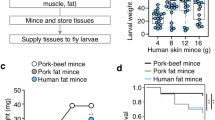Abstract
IN 1929, Baer1 introduced maggot therapy into clinical practice as an adjunct to surgery for the treatment of osteomyelitis. This technique became widely used in North America, and was extended to the treatment of other lesions where there was pyogenie infection or tissue necrosis2. Maggots were believed to have a threefold action within a wound: débridement of necrotic tissue by means of proteolytic enzymes1, stimulation of granulation tissue due to the larval excretion allantoin3 and reduction of wound infection. Baer1 did not consider reduction of wound infection to be merely the result of débridement and tissue stimulation, and Robinson3 has shown that allantoin, even in concentrations up to 8 per cent, has no antibacterial activity.
This is a preview of subscription content, access via your institution
Access options
Subscribe to this journal
Receive 51 print issues and online access
$199.00 per year
only $3.90 per issue
Buy this article
- Purchase on Springer Link
- Instant access to full article PDF
Prices may be subject to local taxes which are calculated during checkout
Similar content being viewed by others
References
Baer, W. S., J. Bone and Jt. Surg., 13, 438 (1931).
Fine, A., and Alexander, H., J. Bone and Jt. Surg., 16, 572 (1934).
Robinson, W., J. Bone and Jt. Surg., 17, 267 (1935).
Black, R. J., “Paper Chromatography” (Academic Press, Inc., New York, 1952).
Author information
Authors and Affiliations
Rights and permissions
About this article
Cite this article
PAVILLARD, E., WRIGHT, E. An Antibiotic from Maggots. Nature 180, 916–917 (1957). https://doi.org/10.1038/180916b0
Issue Date:
DOI: https://doi.org/10.1038/180916b0
This article is cited by
-
First Record of Larval Secretions of Cochliomyia macellaria (Fabricius, 1775) (Diptera: Calliphoridae) Inhibiting the Growth of Staphylococcus aureus and Pseudomonas aeruginosa
Neotropical Entomology (2017)
-
Synthesis of Phenylacetaldehyde from 1-Phenylethan-1,2-diol by Microwave-Assisted Dehydration in Water
Catalysis Letters (2015)
-
Identifying inhibitory compounds in lignocellulosic biomass hydrolysates using an exometabolomics approach
BMC Biotechnology (2014)
-
Maggot metabolites and their combinatory effects with antibiotic on Staphylococcus aureus
Annals of Clinical Microbiology and Antimicrobials (2011)
Comments
By submitting a comment you agree to abide by our Terms and Community Guidelines. If you find something abusive or that does not comply with our terms or guidelines please flag it as inappropriate.



